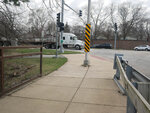Bobsiii
Active Member
Path designers around here (Denver) seem in love with narrow short sharp right-angle entrances to the frequent river/creek crossings. I've found only two with a paved knuckle at the entrance, none built on a diagonal. They also love narrow, short, diving and sharply turning entrances to underpasses with iron railings on the river side. And we have busy busy multi-use paths, especially around downtown area.
My cadence-sensing bike (Magnum Metro) takes about a half rotation for the assist to kick in - just enough to shove me clear across the path if I have to slow/stop for on-coming traffic at a bridge entrance. Struggling to learn how to feather those hydraulic brakes just enough to let me pedal without assist, never had hydraulics before.
The underpasses scare me. Can't see under there, no idea if someone is oncoming and not staying in their lane, underpasses go underwater when the river/creek runs high and so are great for collecting loose gravel; my vivid imagination has me hitting a patch too fast, sliding out with me into the railing and the bike into the river. My speed drops precipitously entering one but most folks seem to fly thru them.
My bike skills were pretty rusty last year when I returned to riding and now with an e-bike I'm finding out just how rusty. Any tips/tricks for dealing with these/similar problems? Is the gravel on path bit just a matter of getting used to the paths, knowing where/when they might have problems and I need to slow and when I can just go?
All in all it seems to me that the paths were afterthoughts put in place by highway engineers.
BTW - bug season has just started here along the river. Didn't eat any yesterday but did have a few fly into the vents on my helmet and crawl. around in the few hairs left up there. Rather disconcerting feeling at 20 mph.
My cadence-sensing bike (Magnum Metro) takes about a half rotation for the assist to kick in - just enough to shove me clear across the path if I have to slow/stop for on-coming traffic at a bridge entrance. Struggling to learn how to feather those hydraulic brakes just enough to let me pedal without assist, never had hydraulics before.
The underpasses scare me. Can't see under there, no idea if someone is oncoming and not staying in their lane, underpasses go underwater when the river/creek runs high and so are great for collecting loose gravel; my vivid imagination has me hitting a patch too fast, sliding out with me into the railing and the bike into the river. My speed drops precipitously entering one but most folks seem to fly thru them.
My bike skills were pretty rusty last year when I returned to riding and now with an e-bike I'm finding out just how rusty. Any tips/tricks for dealing with these/similar problems? Is the gravel on path bit just a matter of getting used to the paths, knowing where/when they might have problems and I need to slow and when I can just go?
All in all it seems to me that the paths were afterthoughts put in place by highway engineers.
BTW - bug season has just started here along the river. Didn't eat any yesterday but did have a few fly into the vents on my helmet and crawl. around in the few hairs left up there. Rather disconcerting feeling at 20 mph.
